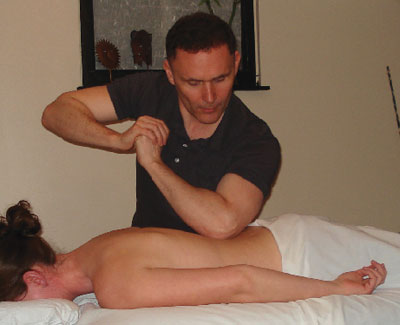
Features
Practice
Technique
Deep Tissue Massage
Deep tissue massage (DTM) is a concept that all RMTs are aware of, yet very few agree on what it involves. Most of us understand DTM in terms of pressure: if we apply more of it, it will penetrate deeper into the tissue. This idea is taught in most massage therapy programs – we progress from superficial to deep, apply a slower rate, add more force with our hands and forearms and use our body weight and muscle power.
October 21, 2010 By Alois NiKodym RMT
Deep tissue massage (DTM) is a concept that all RMTs are aware of, yet very few agree on what it involves. Most of us understand DTM in terms of pressure: if we apply more of it, it will penetrate deeper into the tissue. This idea is taught in most massage therapy programs – we progress from superficial to deep, apply a slower rate, add more force with our hands and forearms and use our body weight and muscle power.

|
| DTM can challenge both the patient’s pain tolerance and the therapist’s endurance.
|
This basic idea still applies: if you use more pressure with your hands, it will indeed penetrate deeper. However, there are limits to this concept, and we are all aware of them:
- Client’s pain tolerance – there is only a certain amount of pressure the client can tolerate before the sympathetic nervous system kicks in and they resist with counter pressure of their muscle tonus and complain of feeling pain.
- Therapist’s endurance – there is a limited amount of power we can generate with our hands for an extended period of time.
- Depth of certain muscle groups – some muscles are covered by layers of superficial muscles, which will absorb most of the pressure, rendering our efforts useless.
- Bruising of capillary beds – even if the above obstacles are overcome, there is still the real possibility of causing injury to the superficial blood vessels.
Therefore, the challenge is not really how to apply more pressure; the challenge is to reach the deeper layers of muscles without crushing the client.
Pressure from within
Being someone who enjoys movies, I often think in terms of movie lines and clips. There is a scene in the movie Get Shorty where the lead character (played by John Travolta), a gangster named Chili Palmer, is approached by another gangster who says, “Hey, it’s Chili on the inside and it’s Chili on the outside.” To paraphrase the line, we can “create pressure on the inside, and pressure on the outside.”
When we activate a muscle, it creates its own internal pressure and, therefore, expands. Watching a bodybuilder flex his pecs and biceps demonstrates this. When this internal pressure is met with external pressure, it becomes possible to reach deeper layers of muscle with much less effort for the therapist and less pain for the client.
Submaximal force for maximum effect
The trick is to deliver a submaximal force to the muscle group we are trying to reach with the manual techniques available to us. This can be achieved with the application of a series of contractions in the concentric or the eccentric phase, or the application of isometric movements or even muscle setting exercises. When we combine those contractions with standard Swedish massage techniques, we suddenly have a new repertoire of skills for the application of deep pressure. Techniques such as myotonic release, active resisted release, isotonic release and passive stretch release are all within our scope of practise of soft tissue manipulation and can easily be learned and incorporated into our treatments.
The results will be a less painful and safer treatment for the client, better outcomes for each treatment, less physical stress on the therapist’s joints and increased longevity of our careers.
Anatomical considerations
There are several anatomical locations where these techniques work very well. One example is the pectoral region. I have worked with a number of bodybuilders over the years, and many of them have a common postural deformity – kyphosis and internal shoulder rotation due to overuse contracture of the pectoral muscles. These muscles are very pain-sensitive with respect to the application of techniques to reduce contracture, but if you contract them, the pain tolerance increases dramatically. If the client performs active resisted isometric horizontal adductions (simulating bench press motion), then deep pressure techniques become tolerable and more effective.
Another example is tennis elbow treatment, a common condition among massage therapists (including myself). Deep petrissage and muscle stripping are difficult to tolerate in the relaxed state, but if you contract the muscle or activate them with active free wrist extensions, the very same techniques lose their pain factor and become more effective and tolerable.
I believe that any condition where the primary aim is to reduce myofascial contracture (iliotibial band syndrome, plantar fasciitis, Dupuytren’s syndrome, kyphosis, lordosis, chronic contusion, muscle strain) would benefit by combining two of the pillars of our scope of practise techniques, active free or resisted movements with deep pressure petrissage and stripping.
Alois Nikodym, RMT, has been practising massage therapy for 20 years and teaching for 15. He operates a small clinic in Toronto, where he specializes in deep tissue massage and Thai massage. He teaches courses on deep tissue massage in Canada, the United States and Europe. To contact him directly, call 416-400-0590 or e-mail: aloisnik@hotmail.com.
Print this page